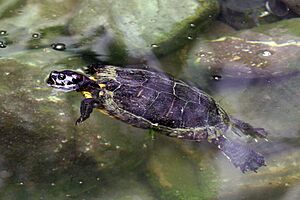Jamaican slider facts for kids
Quick facts for kids Jamaican slider |
|
|---|---|
 |
|
| In Jamaica | |
| Conservation status | |
| Scientific classification | |
| Genus: |
Trachemys
|
| Species: |
Terrepen
|
| Subspecies | |
|
T. terrapen felis |
|
| Synonyms | |
|
|
The Jamaican slider (Trachemys terrapen) is a type of freshwater turtle. It is also known as the Cat Island slider. These turtles belong to the Emydidae family.
You can find them in the Bahamas and Jamaica. Scientists believe they were moved between these two places. For a long time, people thought they came from Jamaica. But new evidence suggests they might have been in the Bahamas first. Ancient people called the Taíno ate these turtles. They also moved them to different islands in the West Indies.
Contents
About the Jamaican Slider
Jamaican sliders are medium-sized freshwater turtles. Male turtles are about 200 millimeters (8 inches) long. Females are larger, reaching about 270 millimeters (10.5 inches). Adult turtles are dark brown or olive green. They have very faint patterns on their shells. Young turtles have clearer markings. These patterns usually fade away by the time they are three years old.
What Do Jamaican Sliders Eat?
Jamaican sliders are omnivores, meaning they eat both plants and animals. They enjoy various fruits, especially pond-apples. They also eat other plants, small fish, and snails. Frogs and aquatic insects are part of their diet too. Sometimes, they might even attack young birds if they are unprotected. However, studies of their waste show that most of their diet is aquatic algae.
Where Do Jamaican Sliders Live?
These turtles live in freshwater areas. They can be found in swamps, streams, and ponds. They even live in temporary ponds that dry up sometimes. They can also live in brackish wetlands, which are areas where fresh and saltwater mix.
Where Can You Find Jamaican Sliders?
The Jamaican slider lives in many parts of Jamaica. It is also found on several islands in the Bahamas. About 60% of the Bahamian population lives on Cat Island. This is why they are sometimes called the Cat Island slider. Smaller groups live on Eleuthera, Andros Island, Exumas, and New Providence.
However, the turtles on New Providence (and nearby Paradise Island) and Exuma are a mix. They are a hybrid of the red-eared slider (T. scripta elegans) and the Inagua slider (T. stejnegeri malonei).
Jamaican Slider Reproduction
In Jamaica, the breeding season for these turtles is from February to September. In the Bahamas, the breeding season might be shorter. This is because freshwater is not always available there. Female turtles lay 3 to 8 eggs at a time. They can lay 3 to 4 groups of eggs each year. The last group of eggs is always smaller than the first.
How People Use Jamaican Sliders
The ancient Taíno people used to eat these turtles. Today, people in the Bahamas still eat them, but this practice is becoming less common. On islands like Cat Island, people sometimes keep these turtles as pets in wells. They are lovingly called "Peter" there.
Protecting the Jamaican Slider
The Jamaican slider is listed as "Vulnerable" by the IUCN Red List. This means they are at risk of becoming endangered. Their populations in both Jamaica and the Bahamas are affected by animals that have been brought to the islands. These include dogs, cats, raccoons, rats, pigs, and mongooses.
In the Bahamas, losing their habitat is a growing problem. This includes Cat Island. Many islands in the Bahamas have little freshwater. So, when hurricanes cause saltwater to mix with freshwater ponds, it harms the turtles.
The biggest concern in the Bahamas is the continued import of red-eared sliders for pets. These turtles are very popular. But when they get too big, people often release them into local ponds. This has caused the Jamaican slider population on New Providence and Paradise Island to mix with red-eared sliders. Luckily, red-eared sliders have not been released on Cat Island yet.


